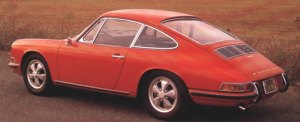| The
rear-bias was always a problem to 911's handling. Any tail-heavy cars have
a tendency to oversteer. If such oversteer is not adequately suppressed,
lost of control may occur. Although there were some racing car being more
tail-heavy and more powerful yet had fabulous handling, say, the 1000 hp
917 Can-Am race car which carried near 70% weight at the rear, the production
911 lacked their racing-spec aerodynamic aid as well as racing tyres -
the original 911 rode on 165 tyres with 4.5 in rims only !
To solve the problem, the
suspension setup, that is, toe-in, camber, castor etc, should be accurately
tuned to optimise the handling ability. However, in production line, such
strict tolerances were found to be impossible to be implemented. Therefore
the following corrective actions were taken :
-
The earliest makeshift solution
was to add weight to the front end. Two 11 kg cast iron weights were added
to the bumper of those 911s with unsatisfactory handling found, officially
called "bumper reinforcement" because it was nothing to proud of. In fact
many drivers of these 911 even didn't know about it !
-
Later, facility was added to
adjust the upper location of the MacPherson strut, making it possible to
adjust both castor and camber to the very close tolerances. As a result,
"bumper reinforcement" was dropped.
-
In 1969, wheelbase was extended
by 2.3 inches by moving the rear axle rearward. At nearly the same time,
wider tyres were adopted, wheel rims widened to 5.5 in and then 6 in. These
changes effectively improved its handling a lot.
-
In the following years, tyres
were continuously widened, from 165 of the original car to 205 front and
245 rear of the 993. Turbo 993 even adopted 225 and 285 tyres. (note that
rear tyres were wider than front) Lost of rear end became very difficult
as a result.
-
Aerodynamic also improved. In
1972, "Duck tail" rear spoiler was introduced in the 911 RS 2.7. It reduced
the rear aerodynamic lift by as much as 75%, thus greatly improved high
speed stability. One year later, an even bigger "whale tail" rear spoiler
appeared in the RS 3.0, then spreaded to all other production 911s in later
years, completely eliminated rear lift.
In its 34 years' history, Porsche
progressively reduced the oversteer manner and eventually built mild understeer
into the 911. The car became better controlled, easier to drive quickly
but some found less fun than the earlier 911s. However, compare with 996,
any 911s still had far more oversteer as well as the fun of challenge. |

